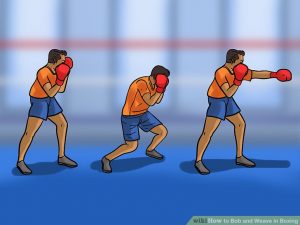In the last article, we introduced some head movement techniques for moderate level boxers. Now, we are going to take your bobbing and weaving to the next level as well. Bobbing (a.k.a ducking) and weaving are two of the most significant defensive moves in the world of boxing.
Are you a pro at both of these techniques? If not, get ready to get on the ropes. Don’t worry, the worst that can happen is you will only exhaust yourself.
You can just come back and keep trying until you get the movement right. If you are shorter than most of your opponents, you need to learn this trick to tackle your rivals. This technique will help you avoid their punches effectively.
How to Perform Bobbing and Weaving?
These moves are difficult to master, you have to face that. But you have to.

Step#1
- Approach your opponent and maintain a safe distance.
- Keep your eyes focused on the chest or eyes of your opponent.
- You must keep your hands up and straight.
- This step will help you spot any movement with no trouble.
Step#2
- You must bend at the knees (not at waist) when your opponent is about to land a punch on your face.
- Once you have bent, you must move your head outside of the punch. Move your head to the right if your opponent throws a left punch. If you are unsure of what to do, move your head in the V-shape motion.
Step#3
- Don’t stand up fully when you are back after ducking.
- Keep your hands straight up and don’t lose your focus from the opponent’s chest or eyes. Keep your eyes straight and right on the point. You must bob and weave over and over again if he is throwing unexpected and fast punches.
Common Mistakes in Bobbing and Weaving
Backed by your opponent behind a corner, you have nowhere to run. Even if you make one small mistake, you are going to fall straight on your face after you enemy’s straight punch on your face. Don’t want that, be aware of the mistakes and avoid the next embarrassing defeat.
Here are some ‘don’ts’ while bobbing and weaving.
- Don’t bend too low while ducking. It is illegal to duck too low as well as it won’t let you come back quickly for a counter punch.
- Don’t try to change your position during this move. Maintain your boxing stance else you might lose your balance and get down for the count.
- Never ever try to bend at waist instead of your knees. Else your challenger might attack you with an uppercut or shovel hook as you moved your eyes away from his chest.
- Don’t try to give patterns to your head on-the-move. If you won’t do it at once, your opponent might catch on your move before your next move.
- Don’t ever move in the same direction as your opponent’s punch. Move outside of this punch so as he may not punch you with his other hand.
How Can You Practice Bob and Weave?
There are fairly simple techniques that can help you practice this move.
Use Rope
- Tie a rope from one ring post to the other.
- When you have maintained your boxing stance, keep the rope at your shoulders’ height.
- The plus point of using ropes (or hand straps) is that you can also shadowbox your enemy while bobbing and weaving.
Call a Partner
- Emulate hooks by calling a partner in the ring.
- You can also measure and adjust your timing and distance from the opponents.
- Call someone who has more height and better range. Don’t forget to tell him to bring his protective gear and boxing gloves.
Masters of Bobbing and Weaving
When it comes to bob and weave, there are two names that come to your mind; Mike Tyson and Joe Frazier.

Tyson was only 5’11’, and was shorter than most of his opponents. He is an exception who can bend at both knees and waist without losing his balance, whereas Joe Frazier used to bend on his knees as well as waist; an incorrect move in the boxing industry. Still he always managed to block an uppercut. How? He used to hold his arms horizontally after covering his head and body.
Now you are well aware of the logic behind Bob and Weave defensive techniques.





